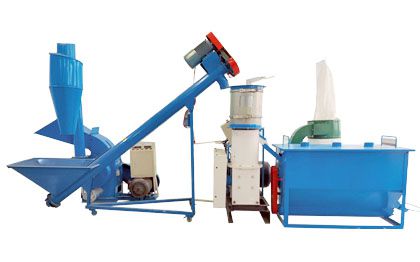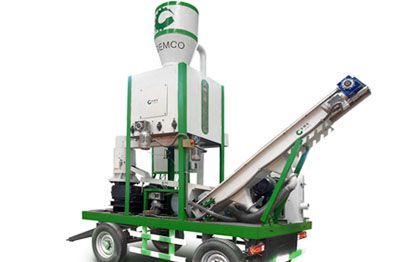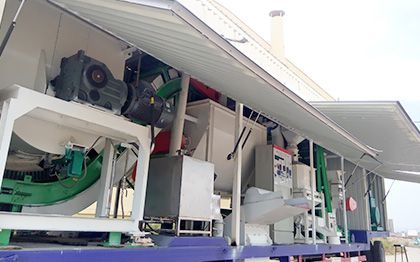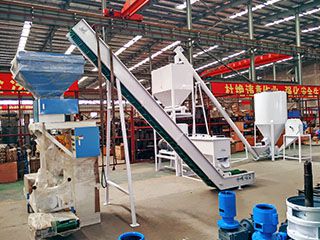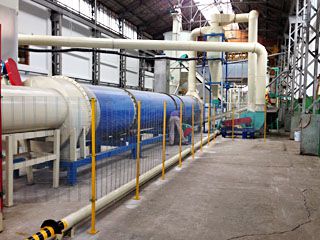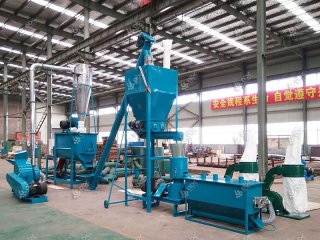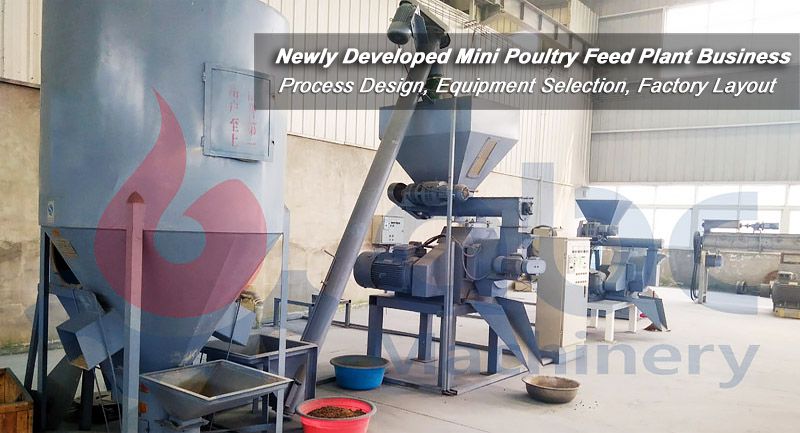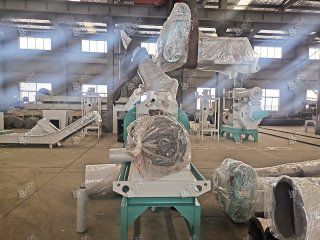Aqua Feed Mill Guide: Tailored Processing for Aquatic Species
With the global population growing and the demand for high-protein food rising, aquaculture has rapidly become the fastest-growing sector in agriculture. Consequently, the market demand for aqua feed has surged. To improve growth rates, reduce feed conversion ratios (FCR), and ensure aquatic animal health, aquaculture businesses are increasingly relying on high-quality feed. Thus, constructing a well-designed aqua feed mill has become essential. This guide will walk you through the essential components of an aqua feed mill, site selection, layout strategies, and equipment configurations—helping you optimize your feed production plant and seize industry opportunities.
- Sinking Feed for Fish Boosts Profit with Dense Pellets
- Floating Fish Feed Production Process Boosts Productivity
- Catfish Feed Production Risks You Must Avoid
- Custom Specialized Trout Fish Feed Pellets Plant Production
- Buy Farmed Salmon Feed Equipment Online
- Tilapia Fish Feed Pellets Solutions to Boost Aquaculture Profits
- Expand Feed Business with Heron Fish Feed Machine
- Get Stable Output with Fish Feed Pelleting Machine
- Optimize Shrimp Feed Manufacturing Process for Growth
- Prawn Feed Manufacturing Machine Cuts Feed Costs
From Concept to Completion: What Makes a Functional Aqua Feed Mill?
After understanding the market potential, the next step is to design an efficient and sustainable feed manufacturing plant. Here are the core systems every successful feed processing plant should include:
 Setup an Aqua Feed Mill at Lowest Cost
Setup an Aqua Feed Mill at Lowest Cost
Raw Material Receiving and Cleaning System
-
Ensures that fish feed ingredients are clean and safe—an essential first step in quality assurance.
-
Functions: Receives bulk or bagged materials like fish meal, soybean meal, corn, etc.
-
Key feed processing equipment: elevators, vibrating screens, permanent magnetic tubes, and destoners.
-
Focus: Remove impurities (metal, stones, dust) to protect downstream feed milling equipment and prevent feed contamination.
Grinding System (Hammer Mill)
-
Improves particle size distribution to enhance feed uniformity and digestibility.
-
Functions: Reduces raw materials to a suitable granularity (typically 60–100 mesh).
-
Equipment: hammer mill, blower, and cyclone separator.
-
Key point: Proper grinding improves pellet formation and digestion. Control temperature rise to prevent nutrient loss during the animal feed production process.
Mixing System (Horizontal/Vertical Mixer)
-
Ensures formula accuracy and uniform quality in fish feed pellets.
-
Functions: Mixes various raw materials with micro-ingredients such as vitamins and minerals.
-
Typical animal feed milling equipment: twin-shaft paddle mixer (high speed and uniformity) and vertical spiral mixer (space-efficient for mid-to-small output).
-
Standard: Coefficient of variation (CV) ≤ 5%.
-
The core of aquatic feed production, determining physical characteristics and palatability.
-
Functions: Converts mixed material into floating or sinking pellets based on species.
-
Equipment: conditioner, ring die pellet mill, extruder—all key feed manufacturing equipment.
-
Technical control: moisture content, extrusion temperature/pressure, screw speed, and recipe.
-
Goal: Uniform density, good water stability, and controllable buoyancy for different aquatic species.
Drying, Cooling, Screening, and Packaging
-
Ensures feed shelf life, product stability, and transport safety.
-
Functions: drying removes excess moisture; cooling prevents spoilage; screening filters unqualified pellets; packaging prepares products for sale.
-
Main animal feed processing equipment: belt dryer, counterflow cooler, rotary screener, auto packaging scale.
-
Requirements: moisture ≤11–12%, water resistance ≥30 min, packaging error ≤±1%.
Floating vs. Sinking Feed: Control Technologies
A professional animal feed processing plant must tailor pellet behavior based on farmed species:
-
Floating feed (e.g., for tilapia, carp): easy to monitor intake and reduces feed processing plant waste.
-
Sinking feed (e.g., for shrimp, catfish, eel): minimizes floating waste and water pollution.
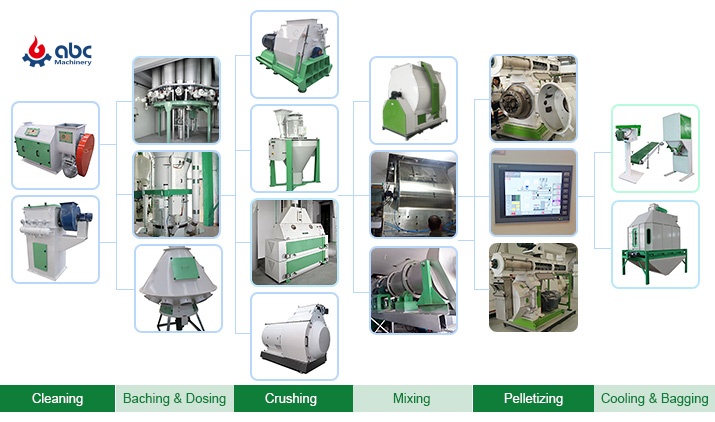
Aqua Feed Pellet Processing Machines of Manufacturing Process
Due to the significant differences in physical feed requirements among various aquaculture species, a single processing solution cannot meet the needs of all product lines. Ignoring the distinction between floating and sinking feeds during the planning stage can severely impact feed palatability and farming performance. If you encounter any challenges in system selection during your design process, feel free to contact us—our engineers are available 24/7 to provide free consultation.
Key Considerations in Building an Aqua Feed Mill
Beyond choosing suitable animal feed processing equipment, other key factors for sustainable and efficient mill operations include:
Site Selection and Infrastructure
-
Choose a location near aquaculture zones or ports to reduce logistics costs.
-
Ensure stable utility supply (especially three-phase electricity).
-
Ground bearing capacity must support heavy animal feed mill plant installations.
Environmental Compliance
-
Dust and noise control systems are required in the feed manufacturing process.
-
Ensure compliance with local environmental regulations.
-
Reserve space for wastewater treatment and environmental equipment.
Raw Material Supply and Storage
-
Storage should support 15–30 days of feedstock.
-
Segregate different materials to prevent cross-contamination.
-
Use automated feeding systems and traceability throughout the feed pellet production line.
Capacity Planning and Scalability
-
Design an expandable feed plant layout and design for future capacity increases.
-
Choose complete feed mill plant setups or modular systems based on species and market demand.
-
Output capacity of the feed production line should align with target species like fish, shrimp, or crab.
Compliance and Certification
-
For export or large-scale buyers, comply with ISO, HACCP standards.
-
Understand local certification requirements before investing.
Choosing the Right Partner
-
Choose feed mill plant manufacturers who offer design, installation, and training services.
-
Ensure timely spare parts supply and fast after-sales service.
-
Evaluate supplier experience and international project references.
 Aqua Feed Pellet Making Line for Sale
Aqua Feed Pellet Making Line for Sale
Start Your Aqua Feed Mill Project with ABC Machinery
ABC Machinery has over 20 years of experience in animal feed machine manufacturers and turnkey feed engineering. We've helped global clients establish profitable and efficient feed plants for various aquatic species. Our advantages include:
-
Free market analysis and capacity planning that reduces project lead time by 20–30% and minimizes setup risk.
-
Custom feed plant layout and design for fast implementation.
-
CE/ISO-certified core equipment with brand components ensures a service life over 10 years and >98.5% uptime.
-
Localized services and engineers ensure zero technical barriers during startup.
-
Lifetime technical support with average response time <24h and access to remote diagnostics.
 Successful Aqua Feed Plant Project
Successful Aqua Feed Plant Project
Choosing ABC Machinery will bring you industry-leading technological innovation and personalized solutions. We deeply understand the unique needs of the aquatic feed industry and are committed to helping customers achieve both production efficiency and product quality by optimizing the performance of feed processing equipment and the process flow of feed processing plants. Our professional team not only has rich international project experience, but also can tailor production lines according to different aquaculture species to ensure that every customer can quickly realize a return on investment. When you cooperate with ABC, you will get not only equipment, but also a trustworthy strategic partner to help you stay invincible in the fierce market competition.Contact ABC Machinery now to start your high-efficiency aqua feed mill project and capture industry growth with confidence!


